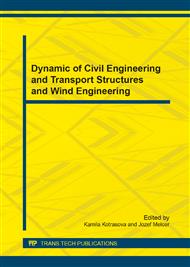[1]
B.E. Melnikov, A.S. Semenov, Strategy of multimodel analysis of elastic-plastic stress-strain state, Berlin Proc. of 6 th Int. Conf. on Comp. Civil and Build. Eng. -Berlin. (1995) 1073-1079.
Google Scholar
[2]
B.E. Melnikov, A.S. Semenov, Creation and application of hierarchical sequence of material models for numerical analysis of elasto-plastic structures, ZAMM Zeitschrift fur Angewandte Mathematik und Mechanik. 76 (1996) 615-616.
Google Scholar
[3]
S. Suresh, Fatigue of Materials, Second Edition, Cambridge University Press, (1998).
Google Scholar
[4]
J. Schijve, Fatigue of Structures and Materials, 2nd Edition, Springer, (2009).
Google Scholar
[5]
S.S. Manson, G.R. Halford, Fatigue and durability of structural materials, ASM Int., (2006).
Google Scholar
[6]
P.A. Pavlov, Foundations of engineering computation the mechanisms parts on fatigue longevity strength, Mashinostroenie, 1988 (in Russian).
Google Scholar
[7]
A.S. Semenov, B.E. Melnikov, M. Yu. Gorokhov, V. Ulbricht, Prevention of cyclic instability at the modeling of elasto-plastic deformation at large strains under proportional and non-proportional loading, Proc. of SPIE, 6597 (2007) 659-710.
DOI: 10.1117/12.726764
Google Scholar
[8]
I.N. Izotov, N.P. Kuznetsov, B.E. Melnikov, A.G. Mityukov, A.Y. Musienko, A.S. Semenov, Modification of the multisurface theory of plasticity with one surface. Comparison with experimental data, Proc. of SPIE, 4348 (2001) 390-397.
DOI: 10.1117/12.417679
Google Scholar
[9]
V.T. Troschenko, V.V. Pokrovsky, A.V. Prokopenko, Metal slopes under cyclic loading, Kiev: Nauk. dumka, 1987 (in Russian).
Google Scholar
[10]
R.E. Peterson, Application of stress concentration factors in design, Proc. Society Expirim, Stress Analysis. 1 (1943) 120-129.
Google Scholar
[11]
O'Donnel, Pordy. Fatigue strength of units with cracks, 2 (1964) 147-159.
Google Scholar
[12]
P.A. Fomichev, J. Polak, Method of calculating the endurance of specimens with a stress raiser. Strength of Materials, 9 (1989) 100-103.
DOI: 10.1007/bf01529306
Google Scholar
[13]
A. Semenov, S. Semenov, A. Nazarenko, L. Getsov, Computer simulation of fatigue, creep and thermal-fatigue cracks propagation in gas-turbine blades, Materiali in Tehnologije, 46 (2012) 197-203.
DOI: 10.1007/s11223-015-9657-8
Google Scholar
[14]
J. Lemaitre, R. Desmorat, Engineering damage mechanics: ductile, creep, fatigue and brittle failures, (2005).
DOI: 10.1002/zamm.200590044
Google Scholar
[15]
A.S. Semenov, S. Saehn, B.E. Melnikov, Computer simulation of kinked fatigue crack propagation at sharp notches, Proc. of SPIE, 3687 (1999) 427-436.
DOI: 10.1117/12.347466
Google Scholar
[16]
A. Sprince, G. Fischer, L. Pakrastinsh, A. Korjakins, Crack propagation in concrete with silica particles. Advanced Materials Research, 842 (2014) 470-476.
DOI: 10.4028/www.scientific.net/amr.842.470
Google Scholar
[17]
A. Sprince, A. Korjakins, L. Pakrastinsh, Time-dependent behavior of high performance fiber-reinforced concrete. Advanced Materials Research, 705 (2013) 75-80.
DOI: 10.4028/www.scientific.net/amr.705.75
Google Scholar
[18]
O.N. Popova, T.L. Simankina, The service life estimation method for the structural elements of residential buildings, Magazine of Civil Engineering, 7 (2013) 40-42.
DOI: 10.5862/mce.42.6
Google Scholar


